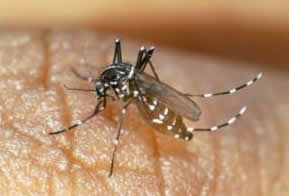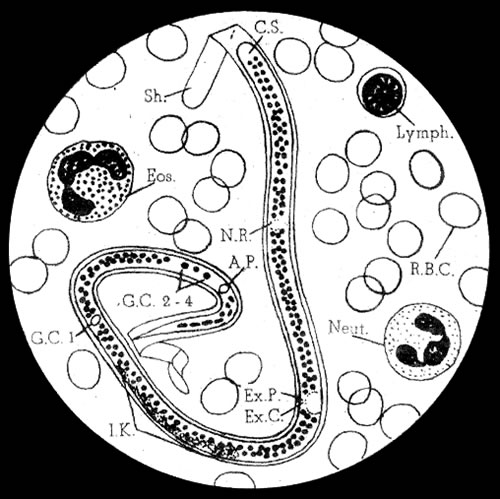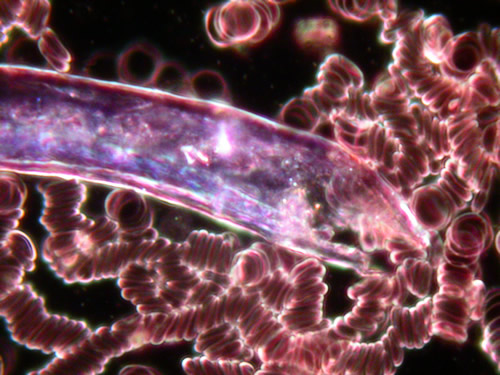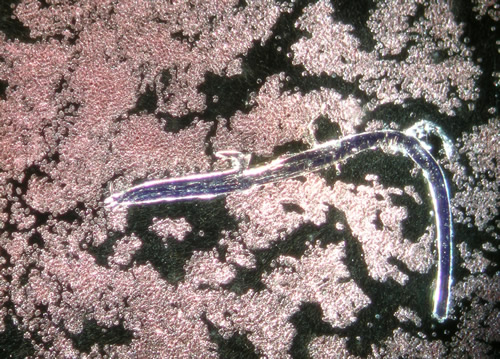Mosquito Infections |
m | ||||||||||
Posted to Subscribers on 15 August 2010 |
|||||||||||
|
|
When starting this post some days after the one on Moss and Mosquitoes, I had already answered more than 80 emails about parasites, but my attempt to post a sequel was delayed by an ankle that wouldn't stop howling! For those with friendly and/or parental instincts towards me, please be assured that I am on the mend and there is nothing to cause you or me worry any more. A few of you did ask about Lyme disease and Morgellon's but these topics are so big that we are looking at a number of posts. It will work out better if the posts are broken into readable lengths according to the vector, the technical name for the creature who introduces the infections into her victims. Mosquitoes Excluding the weaponized mosquitoes, there are 2700-3500 recognized species of mosquitoes. Only female mosquitoes bite. The proboscis of the mosquito is a fascinating piece of anatomy. There is an outstanding picture of it on this page: For a close up of the crucial parts, click below: http://www.astrographics.com/GalleryPrintsIndex/GP2108.html It explains that this tiny death dealing protrusion consists of two pairs of sharp cutters and two tubes, one for sucking up blood and the other for injecting a chemical. The saliva of the females has an anticlotting factor. Wasserman et al (2004) showed that a dose of merely 1/7th of the saliva of a single female mosquito was enough to throw the human immune system into crisis, suppressing T- and B-cell production. When you consider the amount of saliva in a creature that tiny, you no longer feel big and powerful. She can
Diseases Of the thousands of types of mosquitoes, over 100 can spread malaria, history's most deadly disease. Since the beginning of human life on this Planet, two-thirds of all people who ever lived died of malaria. According to the latest DNA studies, this would include the pharaoh Tutankhamun. There are at least 250 million cases of malaria a year, and several cancer patients have told me that cancer feels minor compared to malaria. All mosquitoes of every genus are capable of causing filariasis. There are also viral diseases spread by mosquitoes, serious diseases such as dengue fever, a hemorrhagic fever, as well as yellow fever, West Nile virus, and chikungunya about which I have posted previously. Malaria There are over five million deaths annually due to malaria, a disease whose only known cause is an Anopheles mosquito bite. About half the fatalities occur among children under the age of five. The goal is to eradicate malaria by 2015. The onset of the disease is usually accompanied by fever, chills, achiness, and fatigue. There are four types of plasmodium parasites so the symptoms of infection vary but the pattern is that the blood becomes infected and then the disease moves to the liver where reproduction of the organisms occurs. There could be an absence of symptoms for a time until a new batch of parasites moves into the blood and causes a recurrence. Because the parasite moves inside red blood cells, the blood cells are themselves infected. Then when they burst, the parasites move into the plasma. With each cycle of infection and bursting, anemia worsens. The cycles may be as short as 48-72 hours or they could last months or years, the world record being held by a Greek woman whose infection lasted 70 years. I have met patients who were hospitalized 40-50 times times for recurrent malaria. Once an individual is infected, he or she is not only at personal risk, but if bitten by a mosquito, that mosquito may infect another individual so there is an implied social responsibility as well as whatever concerns one has for oneself. Moreover, this factor easily explains why living in a temperate climate is no assurance of freedom from risk of infection. In recent years, there have been outbreaks of malaria in Ontario, Canada, and the north, south, east, and west of the U.S.: Michigan, Florida, Georgia, Texas, New Jersey, New York, and California.
Filaria Filariasis is caused by a microscopic parasite and there are many possible complications stemming from infection, including lymphedema, elephantiasis, and hydrocele. Microfilaraemic infections are observable in peripheral blood. Failure to detect them in the peripheral blood does not preclude infection. Therefore, if symptoms exist, antigen tests can be performed. Lesions should be lanced and examined microscopically because the parasites can be in the skin, aquaeous fluid of the eyes, and joints. Arthritis is sometimes caused by parasitic infections arising from bites.
In my darkfield studies, I have seen countless people with these types of parasites, which, as noted, can be spread by absolutely any mosquito. To understand the picture above, the smaller circles are red blood cells and the larger ones are various types of white blood cells. You then have a good basis of comparison for the relative sizes of the objects in the blood. I have seen these eating erythrocytes.
Reliable figures for the distribution of lymphatic filariasis are hard to find. I found estimates as low as 40 million to as high as one billion. The parasites move around, probably because of their breeding and feeding habits. Some are viewable using ultrasound but sometimes only between midnight and 2 am. Then, they leave the genitalia and go elsewhere. It's therefore important to emphasize that just because a microscopist or radiologist or someone else fails to find these parasites does not mean that they are not resident in the body.
Once again, there is a need to know because mosquitoes spread the disease from one person to another by biting infected individuals and then healthy ones. The parasites may live for seven years and produce millions upon millions of microfilaria offspring! Treatment usually requires perseverance because adult parasites often withstand some treatment, but even when they do not, they have generally managed to leave their offspring in relatively safe places. Summary While the anopheles mosquito has the worst reputation for infecting people, there are other dangerous mosquitoes as well. The oldest mosquitoes known to exist are found in amber that dates back millions of years. To keep this tidy, the next post will cover prevention and treatment and then the viral infections that were only mentioned in passing here.
Copyright by Ingrid Naiman 2010
Recommended Video:
|
||||||||||
Home || Contact Us |
|||||||||||
No content on any of the pages of this web site may be reproduced without written permission of Ingrid Naiman and Seventh Ray Press, publisher of this site. |
|||||||||||
|
|||||||||||
 collapse your immune system, interfere with blood clotting, circulation, platelet formation, and countless other physiological processes. Experts believe she chooses her victims according to heat, smell, motion, and the carbon dioxide exhaled. The saliva causes a wheal to form that is usually itchy. How long the site remains itchy depends on how rapidly the body breaks down the proteins in her saliva.
collapse your immune system, interfere with blood clotting, circulation, platelet formation, and countless other physiological processes. Experts believe she chooses her victims according to heat, smell, motion, and the carbon dioxide exhaled. The saliva causes a wheal to form that is usually itchy. How long the site remains itchy depends on how rapidly the body breaks down the proteins in her saliva.


